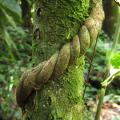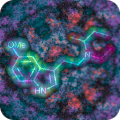
DMT-Nexus member
Posts: 1285 Joined: 23-Jun-2018 Last visit: 22-Feb-2022
|
I read in a thread not long ago about a very simple dmt extraction, which consisted of soaking mhrb powder in acetone and then evaporating to yeild crude extract, and then mini A/B on that. I have no idea if it works but it was being discussed. olympus mon wrote:You need to hit it with intention to get where you want to be! "Good and evil lay side by side as electric love penetrates the sky..." -Hendrix"We have arrived at truth, and now we find truth is a mystery- a play of joy, creation, and energy. This is source. This is the mystic touchstone that heals and renews. This is the beginning again. This is entheogenic." -Nicholas Sand
|
|
|
|
|

❤️🔥
 
Posts: 3648 Joined: 11-Mar-2017 Last visit: 15-Dec-2025 Location: 🌎
|
Showing the phase diagrams for this (at 0C). They show that water saturated with NaOH won't mix with acetone. In unsaturated solutions there is a mix and layers can separate (see tie lines for resulting layer concentrations). Dilute mixes won't separate (bottom right of the diagram on the convex side of the curve).
|
|
|

❤️🔥
 
Posts: 3648 Joined: 11-Mar-2017 Last visit: 15-Dec-2025 Location: 🌎
|
Any concerns with aldol condensation? Does one need to work quickly, not heat, etc? Or are there simply no issues?
|
|
|

❤️🔥
 
Posts: 3648 Joined: 11-Mar-2017 Last visit: 15-Dec-2025 Location: 🌎
|
Loveall wrote:Any concerns with aldol condensation? Does one need to work quickly, not heat, etc? Or are there simply no issues? Answering my own question, I did a test for 24 hours using plain water/NaOH/Acetone at room temperature, and saw no signs of change in the acetone layer. Doesn't seem like aldol condensation is a big concern. I used 30 and 40% NaOH water solutions. However, it does look like a small ammount of water and NaOH can end up in the acetone. I say this because some salt crashed when adding 10% sulfuric drops to the separated acetone layer. This was after starting with 20% NaOH water. This salt formation was avoided if the acetone is dried over MgSO4 after separation (a good practice on general). I would not skip MgSO4 sulfate drying for acetone pulls. Interestingly, adding solid NaOH to the separated acetone layer caused a few ml of water to pool at the bottom along with the excess NaOH. The decanted acetone from this step did not produce salts either. I think this is because the addition of the NaOH to the acetone created saturated NaOH water which separates and creates purer acetone. I think this all makes sense after inspecting the ternary triangle above. One can suck up this small water layer at the bottom (add it back to the base water) and then proceed to add MgSO4 (less is needed this way). Cheers.
|
|
|

DMT-Nexus member
Posts: 2229 Joined: 22-Jul-2011 Last visit: 02-May-2024 Location: in the underbelly of the cosmic womb
|
This is really game changer for me Benzyme.. thanks so much for your contributions! Acetone certainly seems to absorb DMT with more ease than most of the common solvents used for extraction so I'm sure this will make life easier for a lot of people. As far as I have noticed most even complex acacia extracts seem highly soluble in acetone and being so volatile makes it much more desirable than solvents like toluene or xylene for me. Hope all you guys are well.. 
|
|
|

DMT-Nexus member
Posts: 243 Joined: 21-Jul-2019 Last visit: 03-Nov-2024
|
Jees wrote:
Will the caustic not dry the acetone as a welcome effect? If not why?
I am also wondering about this. Would it be recommended to use less water to reduce the chance of water migrating to the acetone?
|
|
|

DMT-Nexus member
Posts: 243 Joined: 21-Jul-2019 Last visit: 03-Nov-2024
|
I ended up trying an a/b with delosperma cooperi but there seems to be barely any separation. I've tried adding more lye and salt but nothing seems to help. Also used about 700 ml of water so maybe that is just too much. Any suggestions? Edit: I managed to resurface some of the acetone by adding a bit more acetone and not agitating at all but rather placing it in a heat bath. Still, a lot is missing though. Woolmer attached the following image(s):  IMG_1791.JPG (1,403kb) downloaded 415 time(s).
|
|
|

❤️🔥
 
Posts: 3648 Joined: 11-Mar-2017 Last visit: 15-Dec-2025 Location: 🌎
|
Woolmer wrote:I ended up trying an a/b with delosperma cooperi but there seems to be barely any separation. I've tried adding more lye and salt but nothing seems to help. Also used about 700 ml of water so maybe that is just too much. Any suggestions?
Edit: I managed to resurface some of the acetone by adding a bit more acetone and not agitating at all but rather placing it in a heat bath. Still, a lot is missing though. I would guess you need even more lye. How much lye and acetone do you have along with the 700g of water? Post #22 has the Gibbs triangle at 0C which may help understand when good separation will happen. Lemme know if you need help reading the triangle it, it is explained in the video below for example:
|
|
|

DMT-Nexus member
Posts: 243 Joined: 21-Jul-2019 Last visit: 03-Nov-2024
|
Thanks Loveall! Your diagram is labeled slightly differently right? The way I read it is that the line which is 45 degrees to the NaOH line is the concentration of acetone to water. Upon choosing a concentration, let's say for example 20:80 acetone:water, you can use the tie lines to find the minimal %weight of NaOH (is this the % weight to water or to the entire system?) which must be added to achieve separation which would be around 18%. For my case, I have used 700 ml of water and around 20-30 ml of acetone, so I would likely need around 22% of NaOH which would end up being about 180 grams for an extraction of 70 grams cooperi. If indeed I am reading this correctly I'd just like to ask whether it would be more beneficial to use much less water as less lye is needed to achieve separation. Woolmer attached the following image(s):  Screen Shot 2563-06-19 at 11.24.20.png (133kb) downloaded 379 time(s).
|
|
|

❤️🔥
 
Posts: 3648 Joined: 11-Mar-2017 Last visit: 15-Dec-2025 Location: 🌎
|
Woolmer wrote:Thanks Loveall!
Your diagram is labeled slightly differently right?
The way I read it is that the line which is 45 degrees to the NaOH line is the concentration of acetone to water. Upon choosing a concentration, let's say for example 20:80 acetone:water, you can use the tie lines to find the minimal %weight of NaOH (is this the % weight to water or to the entire system?) which must be added to achieve separation which would be around 18%. For my case, I have used 700 ml of water and around 20-30 ml of acetone, so I would likely need around 22% of NaOH which would end up being about 180 grams for an extraction of 70 grams cooperi.
If indeed I am reading this correctly I'd just like to ask whether it would be more beneficial to use much less water as less lye is needed to achieve separation. Yes, the video is labeled differently and has different compounds. % are of total weight in the triangle. In your drawing the to top of the triangle is 100% acetone and the bottom right is 100% water. I've added the bottom left which is 100% lye. So your green starting point should be much closer to the water on the bottom right. See image below, I've made your starting green point (before lye) a red point. As you add lye you move the entire system towards the bottom left of the triangle (which represents 100% lye). To read the amount of lye, draw a line parallel to the right side of the triangle and see where it hits the lye axis (examples are shown with dashed lines) Let's say for example, you are 80:20 water:acetone by volume. That is ~80:16 by mass. 18% lye for the water means you are now at 80:16:14 by mass. In % this is ~ 73%, 14.5%, 12.5%, it will hardly separate (barely beyond the 10% lye needed to get inside the tie lines). Complete separation would happen at 28%. I've marked these 10% and 28% points in the triangle. This is for a pure system at 0C. Add plant stuff and being at room temperature and things are worse, I would say you need more lye. Regardless, if you keep on adding lye eventually you should get all your acetone (unless some plant oil is messing up the system). Yes, increasing the acetone/water ratio would be very helpful - especially if this is done by reducing the water. Suppose you start at 40% acetone and 60% water by weight (e.g. you reduced your water before basing and added the same amount of acetone). Then separation starts much sooner (4% total lye), and total separation happens at 22% lye (marked as green in the triangle below). Notice that the diagram is for 0C. At room temp you will need more lye since lye is more soluble in water at room temp. Conversely, in the cold fridge layers will separate better because less lye is needed to saturate the water. I wonder what happens in the freezer, you may get DMT crystals on top of a frozen water layer (that's just a guess). Bottom line is simply add more lye until you get almost all or nearly all the acetone back. You don't want to get back a small amount of acetone because those layers could have some NaOH in them (purple region, which I've drawn a bit too large - cuts off sooner towards the bottom because those are really bottom layers). Benz said before to be very basic and high pH for this to work. The nice thing about this system is how clean the top star is: very pure acetone (as long as enough lye is added). This doesn't always happens (e.g. the system in the earlier video doesn't hit the the pure corner). However, enough lye must be added. The bottom star represents NaOH saturated water. Notice the bottom star is sitting at ~30% NaOH for the total system (with no acetone), that represents 42g of NaOH per 100g of water which is the quoted solubility at 0C here (since 30% = 42/(100+42). So at the end of the day, it is very simple. Saturate the water with NaOH (or nearly saturate it) and separation is complete. At room temp this can be a lot of lye - so reducing the water is a good idea. Also, I would not let this sit for a very long time at warm temps because of the aldol condensation concerns mentioned before (but there may be nothing to this and a simple test showed no issues at room temp for a few hours). Hope I'm making sense 🙂 Loveall attached the following image(s):  TernaryDiagramAnnotated.png (101kb) downloaded 373 time(s).
|
|
|

DMT-Nexus member
Posts: 243 Joined: 21-Jul-2019 Last visit: 03-Nov-2024
|
Thanks again loveall  That makes a lot more sense. I'm assuming salt or maybe even sodium carbonate may help to achieve this separation along with the NaOH. I'd prefer to use less NaOH if possible.
|
|
|

❤️🔥
 
Posts: 3648 Joined: 11-Mar-2017 Last visit: 15-Dec-2025 Location: 🌎
|
Woolmer wrote:Thanks again loveall  That makes a lot more sense. I'm assuming salt or maybe even sodium carbonate may help to achieve this separation along with the NaOH. I'd prefer to use less NaOH if possible.  Worth a try, buy it may not work. As Na+ increases the less soluble salts may start to crash out of solution before the acetone separates well. You may have to use lye to get the full layer of acetone.
|
|
|

❤️🔥
 
Posts: 3648 Joined: 11-Mar-2017 Last visit: 15-Dec-2025 Location: 🌎
|
Loveall wrote:Woolmer wrote:Thanks again loveall  That makes a lot more sense. I'm assuming salt or maybe even sodium carbonate may help to achieve this separation along with the NaOH. I'd prefer to use less NaOH if possible.  Worth a try, buy it may not work. As Na+ increases the less soluble salts may start to crash out of solution before the acetone separates well. You may have to use lye to get the full layer of acetone. Actually, sodium carbonate alone should separate acetone/water well. Saturating the water with sodium carbonate may do the trick, and that happens before lye (by % mass). pH of the water layer should be high enough with less aldol condensation concerns(~12.5). Sorry that the ternary plot I found is rotated, but the discussion is very similar. Loveall attached the following image(s):  Screenshot_20200619-165912.png (118kb) downloaded 322 time(s).
|
|
|

DMT-Nexus member
Posts: 243 Joined: 21-Jul-2019 Last visit: 03-Nov-2024
|
I tried another extraction on D. cooperi with 200 ml water and about 20 ml acetone but could not get the layers to separate. I found that upon adding plentiful lye the plant fats/oils started to migrate to the top instead of drifting to the bottom. I then tried an a/b on some aptenia cordifolia resin that I had and used around 30 ml water, around 10 ml acetone, and some sodium carbonate till saturation. This time upon saturation the plant fats/oils stayed on the bottom layer, while the top layer seemed like a mixture of water/acetone. I pulled some of this water/acetone layer and placed it in dried MgSO4 and noticed how some gunk started to precipitate and create a layer similar to what happened when working with San Pedro resin and acetone/MgSO4/water. I thought maybe this is helping to create the separation layer between the acetone and water as maybe the plant fats are mixing with the water/Na2CO3 while not being soluble in acetone (not sure if that makes sense), so I threw some MgSO4 into main resin/acetone/water mix and noticed the solution separating into three layers. In the top layer was a very dark liquid (highly saturated acetone?), in the middle layer it seemed like the plant fats/oils and water that I observed in the other beaker in paragraph #3, and in the bottom layer a dark orange liquid (hopefully mostly water). The point of separation between the top and middle layer was about at the level where the acetone sat before agitation when I first poured it in. Edit: Just after writing this I took both of the solutions out of the freezer where they had sat overnight. The top layers of both were not frozen but were carrying some gunk from the bottom/middle layer. I poured the acetone that I attempted to dry back into the main container and mixed them. This created a slightly thick green sludge and some immediate separation was observed. Once everything fully melted there was a clear layer between what is hopefully relatively dry acetone and the gunk which has become slightly solid and it seems like the acetone can almost be decanted. Below are pics of the solution after the steps in paragraph #2 and after the steps in the Edit respectively. It may seem as though some gunk is mixing with the acetone layer in the second pic but this is solid and stuck to the vial. Woolmer attached the following image(s):  IMG_5530.jpg (248kb) downloaded 298 time(s). IMG_5536.jpg (375kb) downloaded 298 time(s).
|
|
|

DMT-Nexus member
Posts: 1111 Joined: 18-Feb-2017 Last visit: 12-Jul-2024
|
Loveall wrote:Actually, sodium carbonate alone should separate acetone/water well. Saturating the water with sodium carbonate may do the trick, and that happens before lye (by % mass). pH of the water layer should be high enough with less aldol condensation concerns(~12.5). What about calcium hydroxide? Even less is needed to saturate the water, but will it work for the separation of water and acetone?
|
|
|

❤️🔥
 
Posts: 3648 Joined: 11-Mar-2017 Last visit: 15-Dec-2025 Location: 🌎
|
Jagube wrote:Loveall wrote:Actually, sodium carbonate alone should separate acetone/water well. Saturating the water with sodium carbonate may do the trick, and that happens before lye (by % mass). pH of the water layer should be high enough with less aldol condensation concerns(~12.5). What about calcium hydroxide? Even less is needed to saturate the water, but will it work for the separation of water and acetone? I believe there is no layer separation for Calcium Hydroxide + Water + Acetone.
|
|
|

DMT-Nexus member
Posts: 377 Joined: 19-Aug-2017 Last visit: 15-Jan-2021
|
Is no one else worried about the accidental production of potentially neurotoxic tetrahydro-ß-carbolines by this extraction method?
It is known or widely theorized that 2-substituted ß-carbolines may be notably neurotoxic in ways similar to the toxin MPP+.
Reacting a primary or secondary tryptamine with an aldehyde or ketone results in cyclitization producing tetrahydro-ß-carbolines substituted at the 1 and/or 2 positions. This is why no one ever makes DMT from tryptamine or NMT by the eschweiler-clarke reaction, because rather than DMT you would produce 2-methyl-1,2,3,4-tetrahydro-ß-carboline, a suspected neurotoxin.
When actually intentionally making ß-carbolines this way I believe its an acid catalyst that's used [a bit like using sulfuric acid to salt alkaloid out of acetone] but I seem to recall that a strong base will work as well [like lime or lye] and merely heating tryptamine with acetone has been noted to produce some quantity of 1,1-dimethyl-1,2,3,4-tetrahydro-ß-carboline [1].
Most natural DMT sources also contain NMT, if this reacted with acetone it would form 1,1,2-trimethyl-1,2,3,4-tetrahydro-ß-carboline. A possible neurotoxin.
Acetone is great for some things. I will not be using it for this, given the unknowns and potential risks.
It's kind of a shame, too, because this looks fun.
[1] 'Analytical characterisation of the routes by thermolytic decarboxylation from tryptophan to tryptamine using ketone catalysts, resulting in tetrahydro-ß-carboline formation' Journal of Pharmaceutical and Biomedical Analysis 41 (2006) 872–882
|
|
|

DMT-Nexus member
Posts: 12 Joined: 23-Aug-2020 Last visit: 28-Jul-2025
|
benzyme has worked on ketone catalyzed decarboxylation of tryptophan to tryptamine, but obviously with more bulkier and higher-boiling ketones than acetone. Tryptamine and acetone definitely form the respective imine when left standing at room temperature and below. Pictet-Spengler cyclisation will occur with formaldehyde even under neutral conditions, but can be kept to a minimum at low temperatures. With acetone being bulkier than formaldehyde, imine formation and cyclisation rate will definitely be slower. As benzyme has some experience with those reactions and the analysis, he should definitely chime in. EDIT: Meh, just realised that this is benzyme's thread after all and also from the time when he did some imine-formation reactions with plain tryptamine 
|
|
|

Boundary condition

Posts: 8617 Joined: 30-Aug-2008 Last visit: 29-Nov-2025 Location: square root of minus one
|
Elrik wrote:1,1,2-trimethyl-1,2,3,4-tetrahydro-ß-carboline. A possible neurotoxin. The two methyl groups at the 1-position effectively prevent the full aromatization of the pyridine ring which I believe is necessary for neurotoxic effects to manifest. This toxification reaction would involve the formation of a MPP+ analogue, with a positive charge on the pyridine nitrogen. For this to become possible, one of the two methyl groups at position 1 would have to be oxidized to a carboxylic acid, followed by a decarboxylation - so, an oxidative demethylation in total. Incidentally, there is an analogue of this 1-methyl-1-carboxylic acid derivative which occurs in peyote - the cyclization product of 3-desmethylmescaline and pyruvic acid, an isoquinoline known as peyoruvic acid - although that lacks the extra methyl group on the nitrogen atom. This does at least suggest that the decarboxylation can occur in plants, because there is another alkaloid in peyote corresponding exactly to the decarboxylation product of peyoruvic acid - anhalonidine. The N-methyl derivative of this substance also occurs in peyote and is called pellotine. And (finally!) 1,2-dehydropellotinium, which carries a positive charge on the nitrogen (now technically an iminium), has also been detected in the cactus. I can't comment on the neurotoxicity of this last compound but the presumably trace levels present in peyote do not appear to have caused adverse effects for peyote users over the last 6000 years as far as we know. Perhaps mescaline has a neuroprotectant action in this respect. Perhaps DMT could also act as a neuroprotectant in the presence of 1,1,2-trimethyl-1,2,3,4-tetrahydrobetacarboline but in any case I strongly suspect the neurotoxicity of the compound to be limited for the metabolic reasons already stated at the start of this post. “There is a way of manipulating matter and energy so as to produce what modern scientists call 'a field of force'. The field acts on the observer and puts him in a privileged position vis-à-vis the universe. From this position he has access to the realities which are ordinarily hidden from us by time and space, matter and energy. This is what we call the Great Work." ― Jacques Bergier, quoting Fulcanelli
|
|
|

DMT-Nexus member
Posts: 377 Joined: 19-Aug-2017 Last visit: 15-Jan-2021
|
downwardsfromzero wrote:Elrik wrote:1,1,2-trimethyl-1,2,3,4-tetrahydro-ß-carboline. A possible neurotoxin. The two methyl groups at the 1-position effectively prevent the full aromatization of the pyridine ring which I believe is necessary for neurotoxic effects to manifest. This toxification reaction would involve the formation of a MPP+ analogue, with a positive charge on the pyridine nitrogen. That is a good point that I overlooked. It should prevent any direct aromatization, blocking an analog of MPP+ from forming unless something strange happened in the drugs metabolism. I haven't studied drug metabolism since college and am too rusty to guess if 1-demethylation could be a lesser metabolic fate for the drug. I don't expect it would be a primary route. Even without aromatization we still would be facing a novel compound that likely would be pharmacologically active in some unknown way.
|